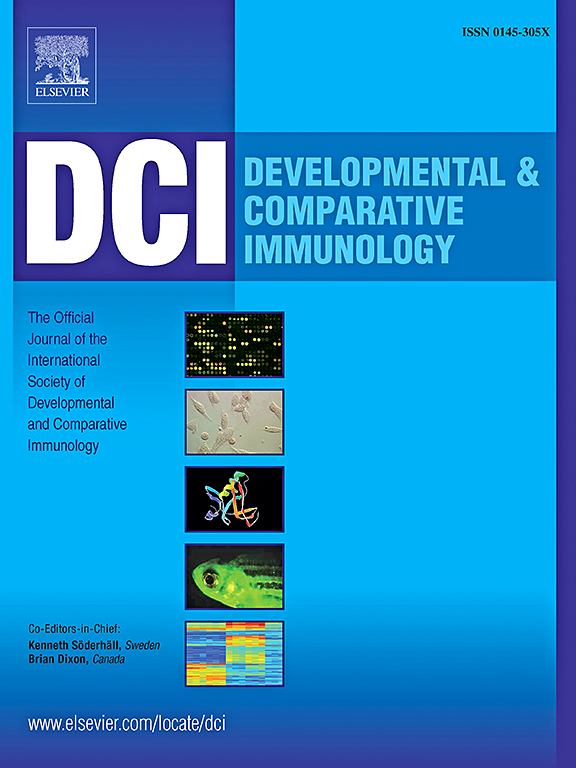寄生腐毛虫对鲤丘疹上皮瘤细胞病理损伤及代谢的影响。
IF 2.7
3区 农林科学
Q1 FISHERIES
引用次数: 0
摘要
腐殖菌病是水产养殖中一种常见的真菌病。它会在鱼的皮肤上形成白色絮状菌丝,菌丝可能向内生长并渗入肌肉组织,从而降低机体的免疫力,最终导致死亡。然而,对鱼体表抵御腐毛虫入侵的机制仍有一些空白。本研究从病原菌和寄主细胞的角度探讨了cyprini上皮瘤乳头状瘤细胞(epelioma papulosum cyprini cell, EPC)在寄生病霉感染过程中的防御机制,为进一步探索寄主抵抗寄生病霉侵袭的机制提供理论依据。以EPC细胞为研究对象。以1×106 CFU/mL的寄生弧菌处理EPC细胞0、6、12、24、48和72 h,检测细胞活力和细胞膜损伤情况,检测细胞非特异性免疫酶活性。在此基础上,检测细胞中凋亡基因和抗氧化基因,分析寄生葡萄球菌对EPC细胞代谢的影响。结果表明,随着寄生弧菌与细胞共培养时间的延长,细胞活力逐渐下降,细胞膜完整性被破坏,但同时非特异性免疫酶活性增强,抵抗寄生弧菌的感染。此外,对EPC细胞凋亡基因casp3a和CTSD的检测显示,casp3a基因的相对含量在24 h时显著增加,达到培养时间的最大值(P本文章由计算机程序翻译,如有差异,请以英文原文为准。
Effects of Saprolegnia parasitica on pathological damage and metabolism of Epithelioma papulosum cyprini cell
Saprolegniasis is a common fungal disease in aquaculture. It will form white flocculent hyphae on the skin of fish, and the hyphae may grow inward and penetrate into muscle tissue, which will reduce the immunity of the body and eventually lead to death. However, there are still some gaps in the mechanism of the fish body surface against the invasion of Saprolegnia. This study explored the defense mechanism of Epithelioma papulosum cyprini cell (EPC) in the process of Saprolegnia parasitica infection from the perspective of pathogenic bacteria and host cells, so as to provide a theoretical basis for further exploring the mechanism of host resistance to S. parasitica invasion. The EPC cell was used as the research object. The EPC cells were treated with 1 × 106 CFU/mL of S. parasitica for 0, 6, 12, 24, 48 and 72 h. Cell viability and cell membrane damage were detected, and the non-specific immune enzyme activity in the cells was detected. Based on the above research, the apoptosis genes and antioxidant genes in the cells were detected to analyze the effect of S. parasitica on the metabolism of the EPC cells. The results showed that with the prolongation of the co-culture time of S. parasitica and cells, the cell viability gradually decreased and the cell membrane integrity was destroyed, but at the same time, the activity of non-specific immune enzymes increased to resist the infection of S. parasitica. In addition, the detection of EPC apoptosis gene casp3a and CTSD showed that the relative content of casp3a gene increased significantly at 24 h and reached the maximum value of the culture time (P < 0.05). The content of CTSD gene increased significantly at 12 h and reached the maximum value (P < 0.05). The results of antioxidant immune genes serpinh1a and gpx1a were opposite to the structure of apoptotic genes. The content of serpinh1a and gpx1a genes decreased significantly at 12 h (P < 0.05), but with the prolongation of culture time, the content increased significantly at 24 h and 48 h (P < 0.05). After stimulation of EPC cells by S. parasitica, the differential metabolites were mainly concentrated in Lipids, Compounds with biological roles and Phytochemical compounds. The KEGG pathway mainly focused on ABC transporters, Glycerophospholipid metabolism, Cysteine and methionine metabolism, Glycine, serine and threonine metabolism, Purine metabolism. In general, S. parasitica can affect cell activity, destroy the cell membrane of EPC cells, and cause apoptosis. However, EPC cells can also resist the invasion of S. parasitica by regulating their own non-specific immunity and their own metabolites, thereby protecting the body from the infection of S. parasitica.
求助全文
通过发布文献求助,成功后即可免费获取论文全文。
去求助
来源期刊
CiteScore
6.20
自引率
6.90%
发文量
206
审稿时长
49 days
期刊介绍:
Developmental and Comparative Immunology (DCI) is an international journal that publishes articles describing original research in all areas of immunology, including comparative aspects of immunity and the evolution and development of the immune system. Manuscripts describing studies of immune systems in both vertebrates and invertebrates are welcome. All levels of immunological investigations are appropriate: organismal, cellular, biochemical and molecular genetics, extending to such fields as aging of the immune system, interaction between the immune and neuroendocrine system and intestinal immunity.

 求助内容:
求助内容: 应助结果提醒方式:
应助结果提醒方式:


